Trainline Bundle
How Did Trainline Revolutionize Rail Travel?
Imagine a world where booking train tickets was as simple as ordering a taxi. Trainline, a pioneer in the digital travel space, transformed the cumbersome process of securing rail and coach tickets. This Trainline SWOT Analysis reveals how a company built a user-friendly platform that streamlined booking across Europe, reshaping the landscape of rail travel.
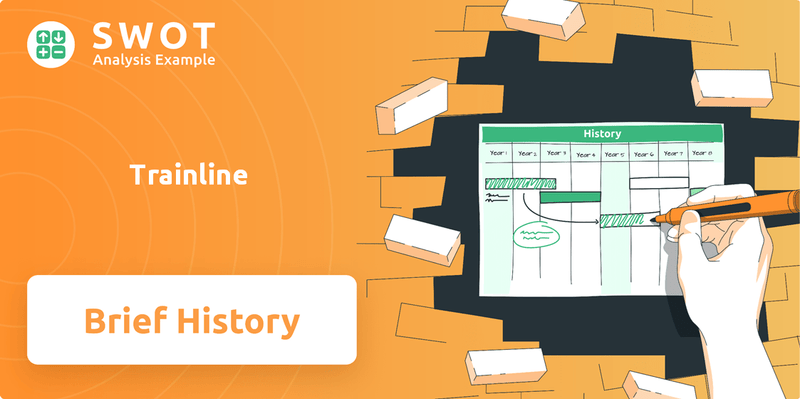
From its inception in 1997, the Trainline company tackled the inefficiencies of UK train travel and beyond, offering a centralized solution for online train tickets. This brief Trainline history highlights how strategic decisions and technological advancements propelled it to become a leading OTA, impacting millions of travelers and setting new standards in the industry.
What is the Trainline Founding Story?
The Trainline company was established in 1997. It began as a joint venture between Virgin Trains and Stagecoach. This marked the inception of a platform designed to streamline the often cumbersome process of booking train tickets in the UK.
The founders identified a clear problem: the fragmented nature of rail ticket purchasing. This often involved visiting physical stations or navigating multiple railway operator websites. Their solution was to create a centralized, user-friendly platform.
The vision was to simplify the search, comparison, and booking of train tickets for consumers. The initial business model centered on providing an online booking service. This offered a single point of access to various rail operators' fares, aiming to streamline the entire customer journey.
Trainline's early days were characterized by a focus on simplifying the booking experience.
- 1997: The year of Trainline's founding.
- Joint Venture: Formed by Virgin Trains and Stagecoach.
- Problem Solved: Fragmented ticket purchasing process.
- Solution: Centralized online booking platform.
Trainline SWOT Analysis
- Complete SWOT Breakdown
- Fully Customizable
- Editable in Excel & Word
- Professional Formatting
- Investor-Ready Format
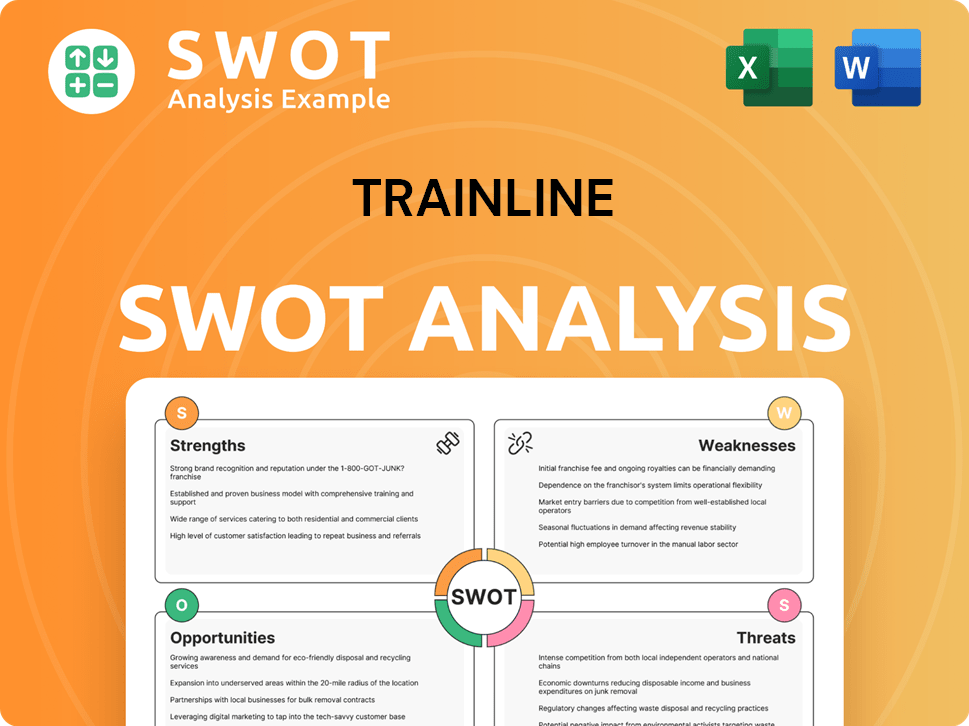
What Drove the Early Growth of Trainline?
The early growth of the Trainline company was characterized by strategic partnerships with UK train operators, which allowed it to broaden its route and fare offerings. Its initial product launches focused on creating a user-friendly and dependable online booking system. As the platform gained popularity, it saw a rise in its customer base, reflected in growing sales and user engagement. Early team expansion was crucial to supporting technological advancements and managing customer service demands.
The company's ability to secure partnerships with various UK train operating companies was fundamental to its growth. This allowed Trainline to steadily increase its inventory of routes and fares, offering more options to its customers. By expanding its network, it catered to a wider audience seeking convenient UK train travel solutions.
Initial product launches concentrated on refining the online booking experience to make it intuitive and reliable for users. This focus on user experience was key to attracting and retaining customers. The goal was to simplify the process of purchasing online train tickets, making it accessible and efficient for all.
As the platform gained traction, Trainline began to attract a growing customer base, evidenced by increasing sales volumes and user engagement. This growth was a direct result of the platform's ease of use and the value it provided to customers. The increasing number of users highlighted the demand for a streamlined rail travel booking service.
Early team expansion was crucial to support technological development and customer service demands. As the company grew, it needed to scale its operations to meet the increasing needs of its users. This included investing in technology to improve the platform and expanding its customer support to handle inquiries efficiently.
A significant phase of expansion involved the company's entry into international markets, particularly across Europe. This geographical expansion was a strategic move to tap into the broader European rail network and cater to a larger audience. Key acquisitions and mergers, such as the acquisition of Qjump in 2006 and the subsequent acquisition by Exponent Private Equity in 2008, further solidified its market position and provided capital for continued growth. The company's IPO in 2019 on the London Stock Exchange marked a major capital raise, enabling further investment in technology and market penetration. Throughout this period, Trainline demonstrated adaptability to market reception and competitive pressures, consistently refining its platform and business model to maintain its competitive edge in the evolving online travel landscape. For more insights, you can read about the Growth Strategy of Trainline.
Trainline PESTLE Analysis
- Covers All 6 PESTLE Categories
- No Research Needed – Save Hours of Work
- Built by Experts, Trusted by Consultants
- Instant Download, Ready to Use
- 100% Editable, Fully Customizable
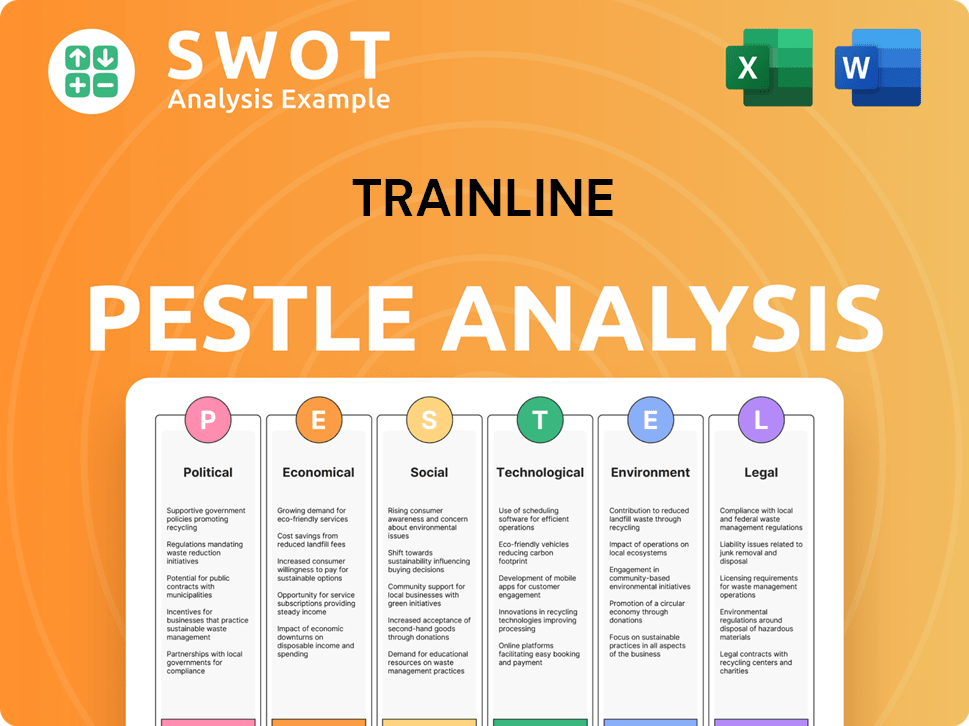
What are the key Milestones in Trainline history?
The Trainline company has achieved several significant milestones throughout its history, fundamentally changing how people book and manage rail travel. From its early days to its current status as a leading platform for online train tickets and UK train travel, the company has consistently adapted and innovated within the dynamic travel industry.
| Year | Milestone |
|---|---|
| 1997 | Founded as thetrainline.com, initially focusing on providing online train tickets. |
| 2007 | Launched its first mobile app, revolutionizing access to rail travel information and ticketing. |
| 2015 | Acquired Captain Train, expanding its presence in the European market. |
| 2019 | Listed on the London Stock Exchange, marking a significant step in its growth. |
| 2020-2021 | Navigated the challenges of the COVID-19 pandemic, adapting services to meet changing travel demands. |
Trainline has been at the forefront of several innovations within the rail travel sector. A key innovation was the early adoption of mobile ticketing and real-time journey updates, greatly enhancing convenience for travelers. The continuous development of its app, consistently ranked as a top travel app, has further simplified how passengers manage their journeys.
Introduction of mobile ticketing allowed passengers to access tickets directly on their smartphones, eliminating the need for paper tickets. This innovation streamlined the boarding process and improved the overall travel experience.
Providing real-time updates on train schedules, delays, and platform information helped travelers stay informed and make informed decisions during their journeys. This feature significantly reduced travel-related stress.
Partnerships with numerous European rail operators expanded the platform's reach, allowing users to book tickets across multiple countries. This integration simplified international travel planning.
Adding coach travel options broadened the platform's offerings, providing users with more choices for their travel needs. This expansion increased the platform's appeal to a wider audience.
The development of an intuitive and easy-to-use app interface made it simple for users to search, book, and manage their train tickets. This user-centric design enhanced customer satisfaction.
Utilizing data analytics to provide personalized recommendations and optimize the booking process improved user experience and increased sales. This approach helped tailor services to individual preferences.
Despite its successes, Trainline has faced several challenges. Intense competition from other online train tickets platforms and direct sales channels from rail operators has consistently put pressure on its market share. Market downturns, such as those during the COVID-19 pandemic, significantly impacted travel volumes, presenting substantial operational and financial hurdles. Read more about Trainline's marketing strategies in this article: Marketing Strategy of Trainline.
The presence of numerous other online travel agencies and direct booking options from rail operators creates a competitive environment. This competition requires continuous innovation and customer focus.
Economic downturns and global events, such as the COVID-19 pandemic, significantly reduce travel demand. These events can lead to financial losses and operational challenges.
Keeping up with technological advancements and ensuring the platform's security and reliability requires continuous investment and adaptation. This includes addressing cybersecurity threats and maintaining system performance.
Adapting to evolving customer preferences, such as the demand for more flexible booking options and sustainable travel choices, requires agility and innovation. This includes offering various payment options and eco-friendly travel choices.
Changes in regulations related to data privacy, consumer protection, and competition can impact the business. Staying compliant and adapting to new laws is crucial.
Managing a platform that integrates with numerous rail operators across multiple countries involves complex operational challenges. This includes handling diverse ticketing systems and ensuring seamless user experiences.
Trainline Business Model Canvas
- Complete 9-Block Business Model Canvas
- Effortlessly Communicate Your Business Strategy
- Investor-Ready BMC Format
- 100% Editable and Customizable
- Clear and Structured Layout
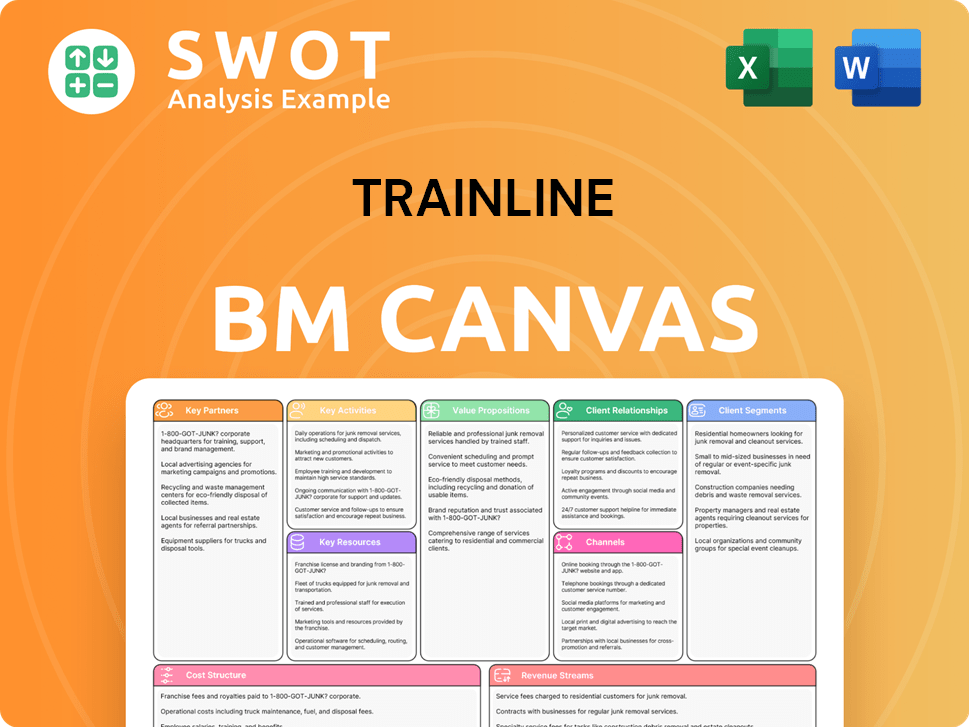
What is the Timeline of Key Events for Trainline?
The Trainline company has a rich history, evolving from a joint venture to a publicly listed company. This journey includes strategic acquisitions, technological advancements, and adaptation to market changes, solidifying its position in the rail travel sector. The company's commitment to innovation and expansion has been key to its growth and success in the online train tickets market.
| Year | Key Event |
|---|---|
| 1997 | Founded as a joint venture, marking the beginning of its journey in the rail travel industry. |
| 2006 | Acquired Qjump, expanding its service offerings. |
| 2008 | Acquired by Exponent Private Equity, signaling a shift in ownership. |
| 2009 | Launched its mobile app, enhancing the accessibility of online train tickets. |
| 2015 | Acquired by KKR, another significant change in ownership. |
| 2016 | Acquired Captain Train, boosting its presence in the European market. |
| 2019 | Listed on the London Stock Exchange (IPO), becoming a publicly traded company. |
| 2020-2021 | Navigated challenges during the COVID-19 pandemic, focusing on digital resilience. |
| 2024 | Continues to grow its reach and tech capabilities across Europe, expanding its services. |
Trainline is focused on expanding its presence across Europe. This includes entering new markets and increasing its service offerings. The company aims to enhance its platform to provide a more seamless experience for customers. This expansion is part of Trainline's broader strategy to dominate the online train tickets market.
The company plans to leverage artificial intelligence and data analytics. This will provide more tailored recommendations and improve the overall travel experience. Trainline is also investing in features like personalized journey planning. These advancements aim to make UK train travel and other European rail travel more efficient.
Trainline recognizes the growing demand for sustainable travel options. This includes promoting rail and coach travel as alternatives to air travel. The company's focus on digital booking supports this trend. Trainline is committed to making rail and coach travel the first choice for consumers.
Trainline prioritizes enhancing the customer experience through its platform. This includes integrated last-mile solutions and improved journey planning. The company aims to simplify the booking process and provide excellent customer support. This focus is integral to Trainline's mission of revolutionizing train booking.
Trainline Porter's Five Forces Analysis
- Covers All 5 Competitive Forces in Detail
- Structured for Consultants, Students, and Founders
- 100% Editable in Microsoft Word & Excel
- Instant Digital Download – Use Immediately
- Compatible with Mac & PC – Fully Unlocked
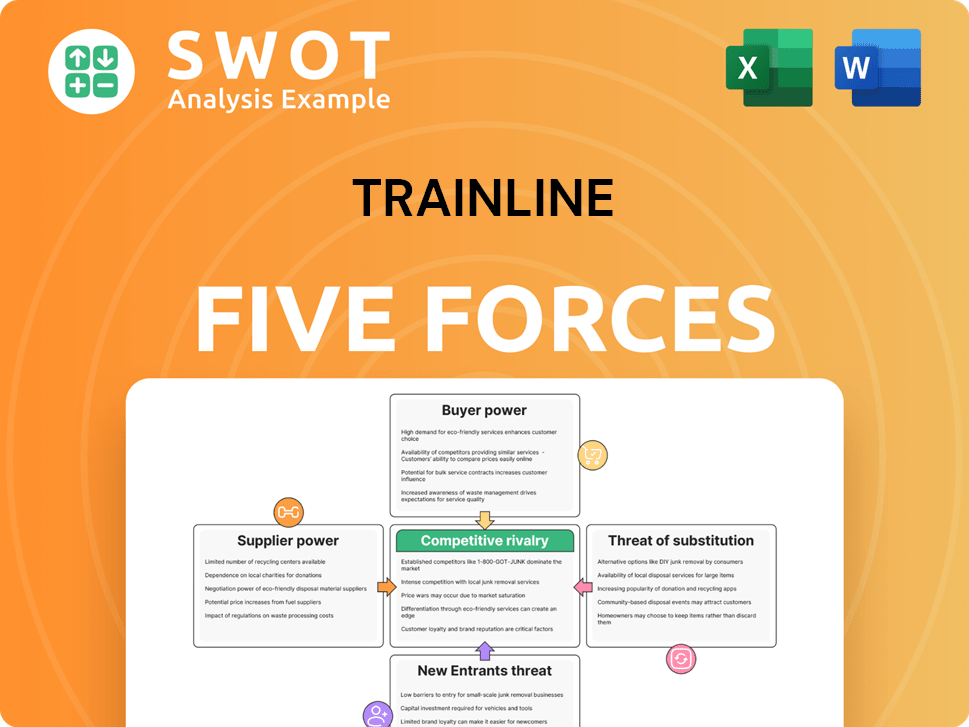
Related Blogs
- What is Competitive Landscape of Trainline Company?
- What is Growth Strategy and Future Prospects of Trainline Company?
- How Does Trainline Company Work?
- What is Sales and Marketing Strategy of Trainline Company?
- What is Brief History of Trainline Company?
- Who Owns Trainline Company?
- What is Customer Demographics and Target Market of Trainline Company?
Disclaimer
All information, articles, and product details provided on this website are for general informational and educational purposes only. We do not claim any ownership over, nor do we intend to infringe upon, any trademarks, copyrights, logos, brand names, or other intellectual property mentioned or depicted on this site. Such intellectual property remains the property of its respective owners, and any references here are made solely for identification or informational purposes, without implying any affiliation, endorsement, or partnership.
We make no representations or warranties, express or implied, regarding the accuracy, completeness, or suitability of any content or products presented. Nothing on this website should be construed as legal, tax, investment, financial, medical, or other professional advice. In addition, no part of this site—including articles or product references—constitutes a solicitation, recommendation, endorsement, advertisement, or offer to buy or sell any securities, franchises, or other financial instruments, particularly in jurisdictions where such activity would be unlawful.
All content is of a general nature and may not address the specific circumstances of any individual or entity. It is not a substitute for professional advice or services. Any actions you take based on the information provided here are strictly at your own risk. You accept full responsibility for any decisions or outcomes arising from your use of this website and agree to release us from any liability in connection with your use of, or reliance upon, the content or products found herein.